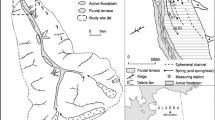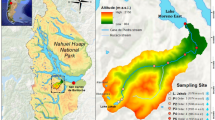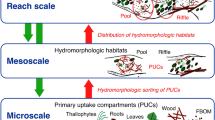Abstract
Water-filled treeholes are temporally and spatially variable habitats that consist of communities of a limited number of insect orders, namely dipterans and beetles. Since these systems are largely heterotrophic, treeholes are dependent on the surrounding terrestrial ecosystem for their basal energy input. In this study, we observed a cyclic succession of three system states in a water-filled Fagus grandifolia treehole: ‘connected’ during rainfall; ‘isolated’ during periods without rain; and ‘dry’ when no freestanding water was present. During the isolated phase, a rapid, microbially mediated turn-over of nitrogen and sulphate took place, coincident with an accumulation of orthophosphate. Ammonium was the dominant form of nitrogen in the treehole water, and a net decrease in its concentration was observed when the water volume decreased. Normally, nitrate concentration showed only minor fluctuations (0.3–1.3 mg l−1) and concentrations of nitrite were very low (3–18 μg l−1). Concentration of sulphate showed a net decrease, coincident with an increase in sulphide. During the connected phase, the effect of stemflow and throughfall on the nutrient concentrations in the treehole water proved to be variable. Over time, both dilution of, and increase in, treehole water nutrient concentrations were observed. Dissolved organic carbon (DOC) concentration showed a net decrease during the isolated phase. Spring coarse particulate organic matter input into the treehole was variable (0.20–1.74 mg cm−2 week−1). The observed variability in precipitation inputs as well as fall-in of organic matter underlines the pulsed character of basal energy entering the treehole food-web. DOC concentrations varied mainly with depth (15–57.4 mg l−1) as concentrations were almost three times greater within the detritus than within the water column. Bacterial abundances ranged from 7.3 × 105 to 9.3 × 106 cells ml−1 and did not appear to vary within the water column or in the detrital sediment. Rates of bacterial production increased 24 h after rain events, suggesting that the combined nutrient fluxes due to increased stemflow stimulate the microbial community.






Similar content being viewed by others
References
Baldwin, D. S. & A. M. Mitchell, 2000. The effects of drying and re-flooding on the sediment and soil nutrient dynamics of lowland river-floodplain systems: a synthesis. Regulated Rivers: Restoration and Management 16: 457–467.
Bowden, W. D., 1986. Nitrification, nitrate reduction, and nitrogen immobilisation in a tidal freshwater marsh sediment. Ecology 67: 88–99.
Carpenter, S. R., 1982. Stemflow chemistry: effects on population dynamics of detritivorous mosquitoes in tree-hole ecosystems. Oecologia 53: 1–6.
Carpenter, S. R., 1983. Resource limitation of larval treehole mosquitoes subsisting on beech detritus. Ecology 64: 219–223.
Cole, J. J. & S. G. Fisher, 1979. Nutrient budgets of a temporary pond ecosystem. Hydrobiologia 63: 213–222.
Eaton, J. S., G. E. Likens & F. H. Bormann, 1973. Throughfall and stemflow chemistry in a northern hardwood forest. The Journal of Ecology 61: 495–508.
Enríquez, S., D. M. Duarte & K. Sand-Jensen, 1993. Patterns in decomposition rates among photosynthetic organisms: the importance of detritus C:N:P content. Oecologia 94: 457–471.
Fish, D. & S. R. Carpenter, 1982. Leaf litter and larval mosquito dynamics in tree-hole ecosystems. Ecology 63: 283–288.
Kaufman, M. G., S. N. Bland, M. E. Worthen, E. D. Walker & M. J. Klug, 2001. Bacterial and fungal biomass responses to feeding by larval Aedes triseriatus (Diptera: Culicidae). Journal of Medical Entomology 38: 711–719.
Kaufman, M. G., W. Goodfriend, A. Kohler-Garrigan, E. D. Walker & M. J. Klug, 2002. Soluble nutrient effects on microbial communities and mosquito production in Ochlerotatus triseriatus habitats. Aquatic Microbial Ecology 29: 73–88.
Kaufman, M. G., E. D. Walker, T. W. Smith, R. W. Merritt & M. J. Klug, 1999. Effects of larval mosquitoes (Aedes triseriatus) and stemflow on microbial community dynamics in container habitats. Applied and Environmental Microbiology 65: 2661–2673.
Kitching, R. L., 1971. An ecological study of water-filled treeholes and their position in the woodland ecosystem. Journal of Animal Ecology 40: 281–302.
Kitching, R. L., 2001. Food webs in phytotelmata: “bottom-up” and “top-down” explanations for community structure. Annual Review of Entomology 46: 729–760.
Lovett, G. M., 1994. Atmospheric deposition of nutrients and pollutants in North America: an ecological perspective. Ecological Applications 4: 629–650.
Merritt, R. W., R. H. Dadd & E. D. Walker, 1992. Feeding behavior, natural food, and nutritional relationships of larval mosquitoes. Annual Review of Entomology 37: 349–376.
Paradise, C. J., 2004. Relationship of water and leaf litter variability to insects inhabiting treeholes. Journal of the North American Benthological Society 23: 793–805.
Paradise, C. J. & W. A. Dunson, 1998. Relationship of atmospheric deposition to the water chemistry and biota of treehole habitats. Environmental Toxicology and Chemistry 17: 362–368.
Paradise, C. J. & K. L. Kuhn, 1999. Interactive effects of pH and leaf litter on a shredder, the scirtid beetle, Helodes pulchella, inhabiting tree-holes. Freshwater Biology 41: 43–49.
Porter, K. G. & Y. S. Feig, 1980. The use of DAPI for identifying and counting aquatic microflora. Limnology and Oceanography 25: 943–948.
Qiu, S., A. J. McComb & R. W. Bell, 2002. Phosphorus-leaching from litterfall in wetland catchments of the Swan Coastal Plain, southwestern Australia. Hydrobiologia 472: 95–105.
Smith, D. C. & F. Azam, 1992. A simple, economical method for measuring bacterial protein synthesis rates in seawater using 3H-leucine. Marine Microbial Food Webs 6: 107–114.
Taylor, F. & A. C. Hendricks, 1987. The influence of fish on leaf breakdown in a Virginia pond. Freshwater Biology 18: 45–51.
Thimonier, A., 1998. Measurement of atmospheric deposition under forest canopies: some recommendations for equipment and sampling design. Environmental Monitoring and Assessment 52: 353–387.
Walker, E. D., D. L. Lawson, R. W. Merritt, W. T. Morgan & M. J. Klug, 1991. Nutrient dynamics, bacterial populations, and mosquito productivity in tree hole ecosystems and microcosms. Ecology 72: 1529–1546.
Wetzel, R. G., 2001. Limnology. Lake and river ecosystems, 3rd edn. Academic Press.
Williams, D. D., 2006. The biology of temporary waters. Oxford University Press.
Yaniovak, S. P., 1999. Effects of leaf litter species on macroinvertebrate community properties and mosquito yield in Neotropical treehole microcosms. Oecologia 120: 147–155.
Yee, D. A. & S. A. Juliano, 2006. Consequences of detritus type in an aquatic microsystem: effects on water quality, micro-organisms and performance of the dominant consumer. Freshwater Biology 51: 448–459.
Acknowledgements
The authors would like to acknowledge financial support from the Natural Sciences and Engineering Research Council of Canada (to D.D.W.), Sarah MacKay for assistance in the field and Edwin Peeters (Wageningen University and Research Centre) for additional support and useful comments.
Author information
Authors and Affiliations
Corresponding author
Additional information
Handling editor: J. Cole
Rights and permissions
About this article
Cite this article
Verdonschot, R.C.M., Febria, C.M. & Williams, D.D. Fluxes of dissolved organic carbon, other nutrients and microbial communities in a water-filled treehole ecosystem. Hydrobiologia 596, 17–30 (2008). https://doi.org/10.1007/s10750-007-9054-9
Received:
Revised:
Accepted:
Published:
Issue Date:
DOI: https://doi.org/10.1007/s10750-007-9054-9




